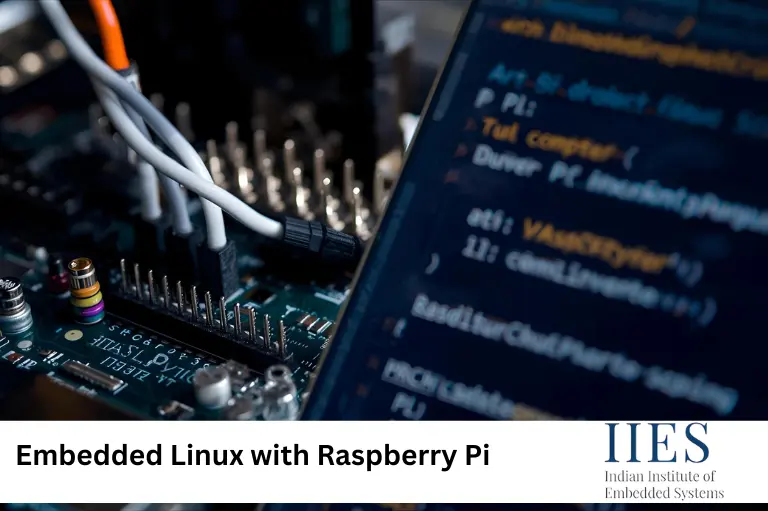
In today’s world of IoT and embedded innovation, mastering Embedded Linux on Raspberry Pi empowers engineers and enthusiasts to design smarter systems with better control, scalability, and performance — from simple sensor-based setups to complex industrial solutions powered by embedded systems training.
Embedded Linux is a Linux operating system tailored for embedded devices. Unlike desktop distributions like Ubuntu or Fedora, Embedded Linux is:
| Feature | Description |
| Device Drivers | GPIO, I²C/SPI, UART, USB, Ethernet (Raspberry Pi GPIO control) |
| File Systems | Standard Linux: ext4; Embedded: SquashFS, JFFS2 |
| Networking | Built-in Wi-Fi/Ethernet; supports TCP/IP, MQTT, HTTP (Raspberry Pi IoT applications) |
| Real-Time Linux | PREEMPT-RT patch for soft real-time tasks (Raspberry Pi real-time applications) |
| Custom OS Build | Yocto Project Raspberry Pi, Buildroot Raspberry Pi for hardware-specific systems |
| Portability | Software can run on Raspberry Pi, BeagleBone, or industrial SoCs |
| Community Support | Extensive forums, tutorials, and open-source libraries |
| Use Cases | IoT gateways, robotics, home automation, media streaming, and industrial monitoring |
| Application | Description |
| IoT Gateways | Collect data from sensors via I²C/SPI and publish to the cloud using MQTT. |
| Home Automation | Control lights, fans, and appliances via Raspberry Pi GPIO control. |
| Robotics | Motor control, sensor fusion, and real-time tasks using Real-time Linux Raspberry Pi. |
| Media Streaming Devices | Deploy Pi as a smart set-top box with Linux multimedia frameworks. |
| Industrial Monitoring | Data logging with SPI/I²C ADCs. |
Linux provides multiple ways to control GPIOs, such as sysfs or libgpiod. Here’s a step-by-step example:
| Command | Purpose |
| echo 17 > /sys/class/gpio/export | Export GPIO 17 |
| echo out > /sys/class/gpio/gpio17/direction | Set GPIO 17 as output |
| echo 1 > /sys/class/gpio/gpio17/value | Turn GPIO HIGH |
| echo 0 > /sys/class/gpio/gpio17/value | Turn GPIO LOW |
#include
#include
int main() {
struct gpiod_chip *chip;
struct gpiod_line *line;
chip = gpiod_chip_open("/dev/gpiochip0");
line = gpiod_chip_get_line(chip, 17);
gpiod_line_request_output(line, "led", 0);
gpiod_line_set_value(line, 1); // LED ON
sleep(2);
gpiod_line_set_value(line, 0); // LED OFF
gpiod_chip_close(chip);
return 0;
}
| Situation | Recommended Approach |
| Learning & Prototyping | Raspberry Pi OS (Debian-based), standard drivers, GPIO experiments. |
| Custom Hardware Integration | Buildroot Raspberry Pi or Yocto Project Raspberry Pi to include only the required drivers. |
| IoT Applications | Use MQTT, HTTP, and GPIO/I²C/SPI for sensor interfacing. |
| Real-Time Requirements | PREEMPT-RT Linux kernel for timing-sensitive tasks (Real-time Linux Raspberry Pi). |
| Industrial Deployment | Use Compute Module or industrial-grade Pi boards with long-term reliability. |
| Benefit | Explanation |
| Open-source | Free to use with strong community support. |
| Scalability | Rapid prototyping and smooth transition to production. |
| Flexibility | Choose a standard OS or a fully customized build. |
| Peripheral Support | GPIO, SPI, I²C, UART, PWM, USB, Ethernet. |
| IoT-ready | Integrates easily with cloud services and IoT protocols. |
Embedded Linux Raspberry Pi combines the flexibility of Linux with practical embedded hardware. For Raspberry Pi Linux projects, IoT devices, robotics, or industrial systems, the Pi platform is ideal for prototyping and deployment. Beginners get a solid learning experience, while professionals can scale to real-world applications using Yocto Project Raspberry Pi, Buildroot Raspberry Pi, and Real-time Linux Raspberry Pi.
Embedded Linux is trimmed, optimized for specific hardware, and designed for low power and high reliability.
Yes, using the PREEMPT-RT kernel patch.
Yocto Project Raspberry Pi, Buildroot Raspberry Pi, and OpenEmbedded.
Yes, especially industrial-grade variants like Compute Module or Pi Industrial Boards.
Indian Institute of Embedded Systems – IIES